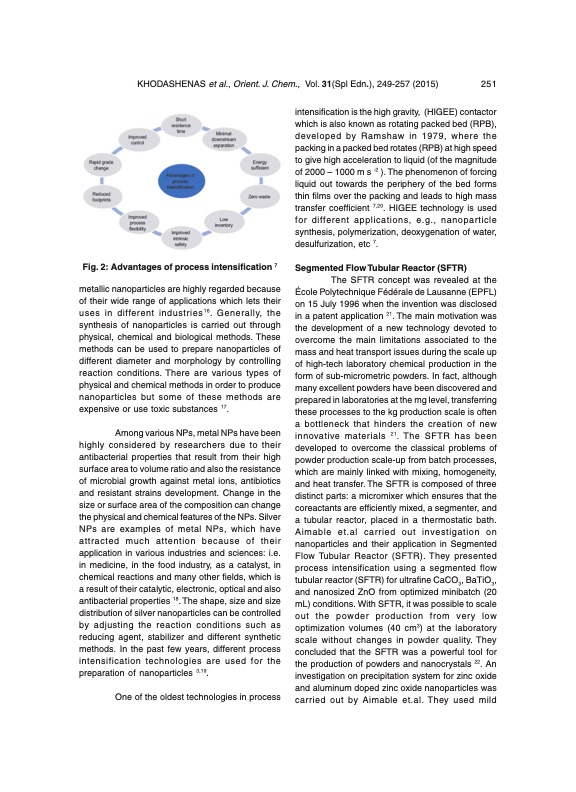
PDF Publication Title:
Text from PDF Page: 003
KHODASHENAS et al., Orient. J. Chem., Vol. 31(Spl Edn.), 249-257 (2015) 251 Fig. 2: Advantages of process intensification 7 metallic nanoparticles are highly regarded because of their wide range of applications which lets their uses in different industries16. Generally, the synthesis of nanoparticles is carried out through physical, chemical and biological methods. These methods can be used to prepare nanoparticles of different diameter and morphology by controlling reaction conditions. There are various types of physical and chemical methods in order to produce nanoparticles but some of these methods are expensive or use toxic substances 17. Among various NPs, metal NPs have been highly considered by researchers due to their antibacterial properties that result from their high surface area to volume ratio and also the resistance of microbial growth against metal ions, antibiotics and resistant strains development. Change in the size or surface area of the composition can change the physical and chemical features of the NPs. Silver NPs are examples of metal NPs, which have attracted much attention because of their application in various industries and sciences: i.e. in medicine, in the food industry, as a catalyst, in chemical reactions and many other fields, which is a result of their catalytic, electronic, optical and also antibacterial properties 18. The shape, size and size distribution of silver nanoparticles can be controlled by adjusting the reaction conditions such as reducing agent, stabilizer and different synthetic methods. In the past few years, different process intensification technologies are used for the preparation of nanoparticles 3,19. One of the oldest technologies in process intensification is the high gravity, (HIGEE) contactor which is also known as rotating packed bed (RPB), developed by Ramshaw in 1979, where the packing in a packed bed rotates (RPB) at high speed to give high acceleration to liquid (of the magnitude of 2000 – 1000 m s -2 ). The phenomenon of forcing liquid out towards the periphery of the bed forms thin films over the packing and leads to high mass transfer coefficient 7,20. HIGEE technology is used for different applications, e.g., nanoparticle synthesis, polymerization, deoxygenation of water, desulfurization, etc 7. Segmented Flow Tubular Reactor (SFTR) The SFTR concept was revealed at the École Polytechnique Fédérale de Lausanne (EPFL) on 15 July 1996 when the invention was disclosed in a patent application 21. The main motivation was the development of a new technology devoted to overcome the main limitations associated to the mass and heat transport issues during the scale up of high-tech laboratory chemical production in the form of sub-micrometric powders. In fact, although many excellent powders have been discovered and prepared in laboratories at the mg level, transferring these processes to the kg production scale is often a bottleneck that hinders the creation of new innovative materials 21. The SFTR has been developed to overcome the classical problems of powder production scale-up from batch processes, which are mainly linked with mixing, homogeneity, and heat transfer. The SFTR is composed of three distinct parts: a micromixer which ensures that the coreactants are efficiently mixed, a segmenter, and a tubular reactor, placed in a thermostatic bath. Aimable et.al carried out investigation on nanoparticles and their application in Segmented Flow Tubular Reactor (SFTR). They presented process intensification using a segmented flow tubular reactor (SFTR) for ultrafine CaCO3, BaTiO3, and nanosized ZnO from optimized minibatch (20 mL) conditions. With SFTR, it was possible to scale out the powder production from very low optimization volumes (40 cm3) at the laboratory scale without changes in powder quality. They concluded that the SFTR was a powerful tool for the production of powders and nanocrystals 22. An investigation on precipitation system for zinc oxide and aluminum doped zinc oxide nanoparticles was carried out by Aimable et.al. They used mildPDF Image | Process Intensification for the Synthesis of Metal Nanoparticles

PDF Search Title:
Process Intensification for the Synthesis of Metal NanoparticlesOriginal File Name Searched:
sdr-synthesis-metal-nanoparticles.pdfDIY PDF Search: Google It | Yahoo | Bing
Turbine and System Plans CAD CAM: Special for this month, any plans are $10,000 for complete Cad/Cam blueprints. License is for one build. Try before you buy a production license. More Info
Waste Heat Power Technology: Organic Rankine Cycle uses waste heat to make electricity, shaft horsepower and cooling. More Info
All Turbine and System Products: Infinity Turbine ORD systems, turbine generator sets, build plans and more to use your waste heat from 30C to 100C. More Info
CO2 Phase Change Demonstrator: CO2 goes supercritical at 30 C. This is a experimental platform which you can use to demonstrate phase change with low heat. Includes integration area for small CO2 turbine, static generator, and more. This can also be used for a GTL Gas to Liquids experimental platform. More Info
Introducing the Infinity Turbine Products Infinity Turbine develops and builds systems for making power from waste heat. It also is working on innovative strategies for storing, making, and deploying energy. More Info
Need Strategy? Use our Consulting and analyst services Infinity Turbine LLC is pleased to announce its consulting and analyst services. We have worked in the renewable energy industry as a researcher, developing sales and markets, along with may inventions and innovations. More Info
Made in USA with Global Energy Millennial Web Engine These pages were made with the Global Energy Web PDF Engine using Filemaker (Claris) software.
Infinity Turbine Developing Spinning Disc Reactor SDR or Spinning Disc Reactors reduce processing time for liquid production of Silver Nanoparticles.
| CONTACT TEL: 608-238-6001 Email: greg@infinityturbine.com | RSS | AMP |